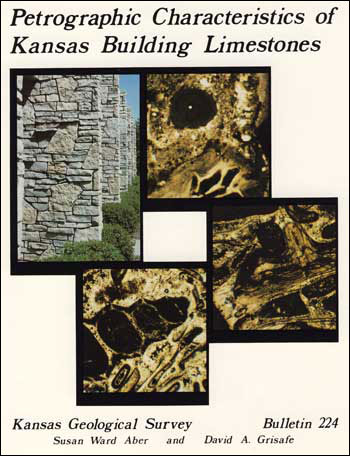Petrographic Characteristics of Kansas Building Limestones
DOI:
https://doi.org/10.17161/kgsbulletin.no.i224.22274Abstract
Thin sections of eight different Kansas building limestones, taken from current quarry sites, were studied parallel and perpendicular to their bedding plane. A comparison of the result Ing data shows that considerable variations in the petrographic characteristics occur among these limestones.
The Five Point Limestone in northeastern Pottawatomie County is a highly fossiliferous, medium- to coarse-grained packstone with color varying from brownish-yellow to pinkish-gray and possessing around seven percent porosity. In Riley County the Neva Limestone is a fine- to medium-grained, pellet-bearing wackestone with a light gray color. It is divided into hard and soft ledges, with porosities of less than one and two percent, respectively; the latter ledge contains three times as many opaques as the former. The light gray Cottonwood Limestone in Chase County is divided into upper and lower ledges. The upper bed is a fine- to medium-grained fusulinid wackestone with five percent porosity, while the lower bed is a fine-grained wackestone with less than one percent porosity. In eastern Pottawatomie County, the Funston Limestone is a fine- to medium-grained wackestone with a light buff-gray color and 12 percent porosity. The Fort Riley Limestone in southern Cowley County is a fine- to medium-grained algal wackestone/packstone with a light brownish-yellow color and five percent porosity. The Cresswell Limestone in Cowley County is a very fine grained, burrowed, pellet-bearing wackestone that is nearly white in color and has less than one percent porosity.
Downloads

